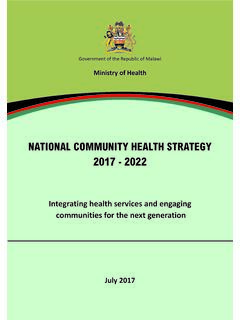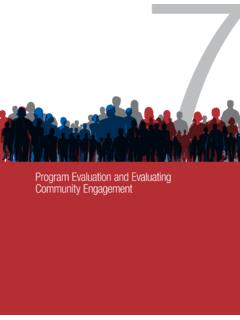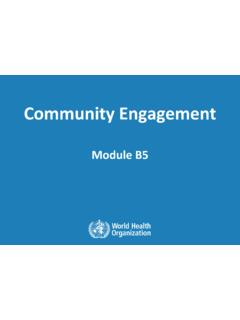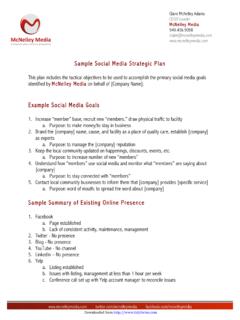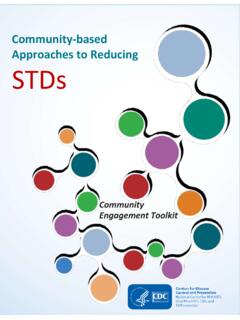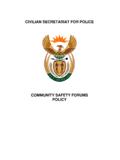Transcription of Best Practices for Meaningful Community Engagement
1 ?!x Best Practices for Meaningful Community EngagementTips for Engaging Historically Underrepresented Populations in Visioning and Planning The wider the variety of world views and lived experiences that inform a Community visioning or planning process, the more likely it is that the built project or resulting plan will address the needs and opportunities of even the most vulnerable or most marginalized person in the Community . Meaningful Community Engagement can take shape in a variety of ways and requires time and flexibility. Building trusting relationships with people and finding a variety of ways to enable their connection to a project, a process, or a group of people requires sustained effort. Here are some tips to help strengthen the interpersonal connections across your Community :Identify who is underrepresented at your meeting or event.
2 Why do you define this particular population this way? How can this information guide your planning and outreach efforts?Put yourself in other people s shoes. What factors (besides meeting content) would guarantee your attendance? How might you eliminate common barriers to showing up?*Listen more than you speak. Seek the perspective, expertise and lived experience of each person you input and buy-in on your project, its aims, and its marketing materials. Seek input from the groups you are actively trying to engage. Invest time in building relationships with grassroots Community leaders who may serve as information conduits. Acknowledge their time and efforts explicitly. Address language barriers. Eliminate use of technical jargon and acronyms during all new terminology on the white board, or in a glossary of terms, where everything is boiled down into easy-to-grasp language.
3 Dedicate funds in your project budget for interpretation and translation services. Connect with Community nonprofits and cultural groups to gather information:What language(s) does your constituency speak? Is literacy an issue?Who might you recommend to do translation into X language? Can you introduce me to that person?Be thoughtful about location of meetings and events. Can everyone get there easily via public transit, especially by bus? Is the location neutral or known to be the turf of a particular group? Is the venue familiar and accessible to everyone involved?Get creative in defining what Engagement looks and feels like. Meetings are just one way of gathering people and exchanging information. Create a multitude of ways for people to get involved. Hands-on activities a river cleanup or a playground build get people working side-by-side, sharing an experience, meeting and speaking with one another.
4 Tap existing networks to spread the word. Published public notices may follow the letter of the law, but they can never replace intentional outreach or one-to-one Engagement . Word of mouth is time-tested and never goes out of style! Invest time in connecting with member organizations to multiply your food and child care at all events. Publicize these offerings in your outreach. Create ways for children to contribute and participate in the process, and publicly acknowledge citizen distrust and historical patterns of decision making that is not reflective of previously gathered public input. If you name it and own it, you set the tone for open conversation. Demonstrate you are willing to engage honestly and without hard expectations by being up front and honest. Let participants know all the non-negotiables up front.
5 Be transparent in describing your team s roles and responsibilities, capacities and limitations, especially time and financial constraints. Don t solicit input if there s no opportunity to influence a decision already made!Take time to establish rules of Engagement , sourced from stakeholders in the room. Build stakeholder ownership of the process from the beginning, and warm up the room and the voices within it. Establish shared culture and norms regarding expectations for participation, boundaries for folks who might take more air time, and permission for those who tend to say less in a group your team s manner and practice reflect core principles of inclusiveness, equity, justice, reliability, respect, transparency, cultural competence, and active it right when something goes wrong.
6 When receiving feedback about meeting format, or something said or unsaid, be gracious. Validate the concerns of the messenger, and make a verbal correction or acknowledgement in real time.*See next page for Commonly Cited Reasons Why People Don t Show Cited Reasons Why People Don t Show UpInsights from the Field on Engaging Historically Underrepresented Groups in Visioning and PlanningA key step in preparing to lead a Community visioning and planning process, along with cultural competency training, includes educating yourself and your team about possible reasons why people don t show up at public meetings or participate in planning processes. Practitioners interviewed by the Groundwork USA team shared the following commonly cited reasons for not showing up: Lack of knowledge of the political system Previous negative Community Engagement experience Historical patterns of municipal decisions not reflecting Community input, broken promises made by political candidates, or both, resulting in reinforced distrust of government and institutions Economic barriers.
7 Needing to focus on basic needs of self and family Not seeing one s own culture or identity reflected in meeting format or content Fear of being judged, unsafe, or unwelcome Transportation barriers Childcare needs Spiritual beliefs and Practices Immigration status Meeting time or date does not consider work schedules, religious holidays, meal times, or other family needsWhile not definitive, these perspectives are valid and should be taken into account when planning a meeting or gathering of any kind.!x Examining Who May Be Underrepresented and WhyFood for Thought from Practitioners Who ve Been TherePrecise and intentional language is important when communicating with members of the public, and especially so in Community visioning and planning work. From interviews the Groundwork USA team led with seasoned Community organizers in creation of this tool, we define hLVWRULFDOO\ XQGHUUHSUHVHQWHG populations as those groups or communities who experience social exclusion and disempowerment.
8 EQJDJLQJ KLVWRULFDOO\ XQGHUUHSUHVHQWHG populations requires a team to modify the activities it typically employs in its outreach, communications, or Engagement strategy to connect with them include: People whose preferred language is one other than English People with low levels of literacy Single parents or working parents People of color Immigrants Refugees People with disabilities Faith communities People who are LGBTQ (Lesbian, Gay, Bisexual, Transgender, Questioning) Ex-offenders Individuals who are homeless Youth EldersKeeping these populations in mind, to be able to reach into a neighborhood and connect with all kinds of people, the first questions a Community Engagement team should ask themselves and answer honestly are: Why are particular segments of our Community s population frequently missing from planning or public process, and what will we do about it?
9 !x
